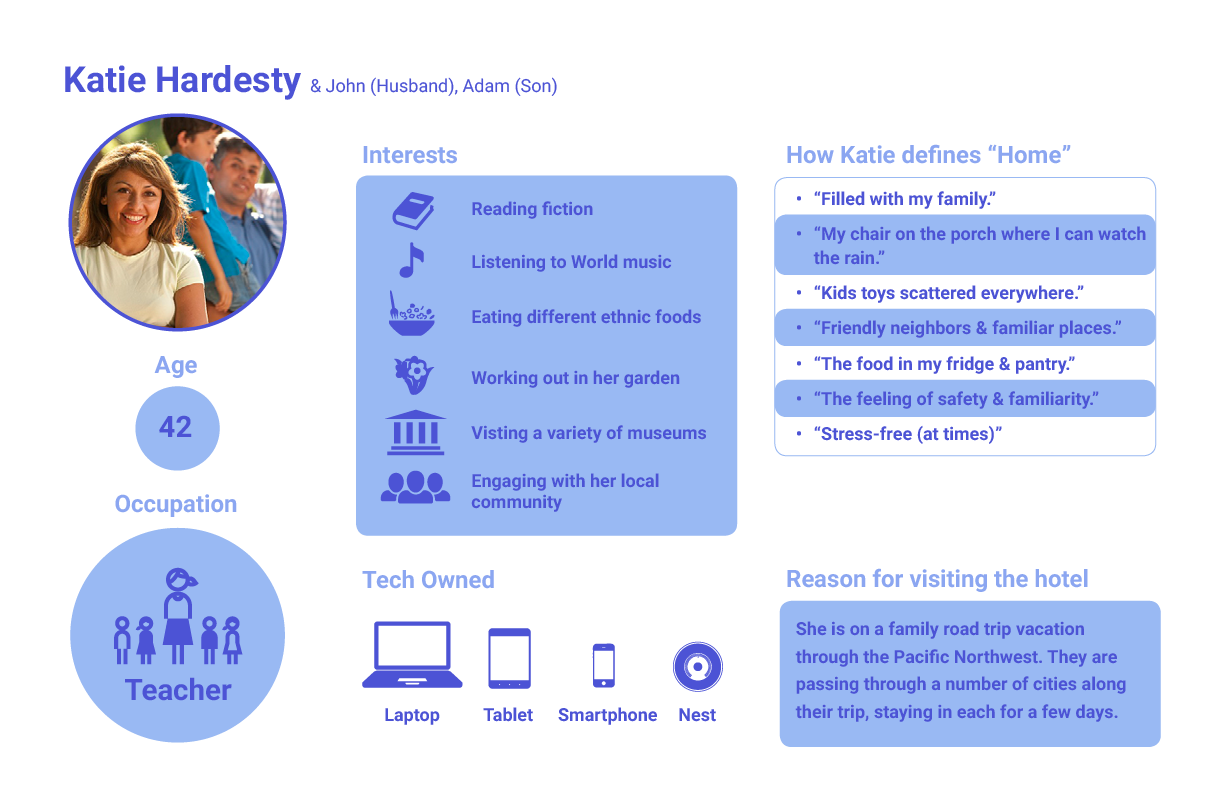My Approach
Rather than focus solely on the adaptability of the room or hotel, my approach has been to understand the meaning of “home” in the mind of our guests and apply design extensions that embody that philosophy into many different touch points along the entire travel journey. “Home” is more than just a place, it is a state of mind that includes comfort, familiarity, security, accessibility and many other emotional qualities that ladder up to peace of mind.
Insights
The best way to wrap your head around a problem is often to talk to people first and understand their perspectives on the tensions that exist in the current experience. I talked to a number of people about how they would define ‘home,’ their experiences in hotels, and how it all matters to them in a larger sense. Below, I’ve distilled some of the research into a few key insights I’d like to explore further.
Feeling of Familiarity
Whether at home or in a hotel, people want to have things just work the way they are used to. The house is also your “home base” of operations, you know where everything in the neighborhood is — the restaurants, bars, music venues, museums, etc — and there is a comfort in that.
Stress-Free
Home is a place where you can be yourself, it’s your “safe place” and you live by your own set of rules. In a hotel, you are in a new place, there are things to consider, activities to plan, and tasks to complete. Hotels have a set of conventions that a guest must complete or consider before, during, and after their stay. So, how can you help make the hotel stress-free?
Different, Yet Similar
Your hotel isn’t your home, and it shouldn’t be. There are wonderful things that a hotel experience can offer, and a change of pace is often welcomed. That being said, there are things that hotels can do a lot better to make it have some of those attributes that make a ‘home’ so welcoming.
Above is a visualization of aspects and connections of what makes home a home. Some of the main insights were distilled down and represented as emotions (familiarity), people (neighbors, family), the neighborhood (community), and things (material goods). This was an important exercise to help me understand the essence of home and what it means to people.
Personas – Our Guests
Personas become a very helpful tool when you are trying to craft a user journey, and begin to dive deep into what an experience could or should look like. I created two personas here, one of a young traveling businessman named Bob, and the other of a mom, Katie, traveling with her family around the Pacific Northwest. For the sake of time, and to illustrate some of the touchpoints and highlight the experiences of this digital solution, I will focus on Bob’s story and hotel experience below.


Introducing the ‘Portable Smart Home’
Smart homes are coming, no doubt about that. But how can we translate all that accumulated data and those personal tweaks from your home into a hotel experience? The key is utilizing Google’s suite of products to pull together all the different data, and create a seamless, effortless experience delivered right to your phone through the Google Now interface. When a person leaves from their home to the hotel, they bring their data with them, and their hotel room is transformed into the Smart Hotel — it’s a Portable Smart Home. Data doesn’t make the home, but it can help influence and work to create a level of comfort that you can’t quite place your finger on. Entering a hotel room, your lights are the same brightness as home, the shower height is high enough for you to not crouch, all your media is at your fingertips… It just works, and in fact, you should never even notice the Hotel adapted to you, it’s all in the background to just take stress out of the equation. It understands what you need, before you even know you need it.
The Concept & Designs
When approaching this project I considered building an app or a website, but I soon realized that the ideal experience I was looking for already had a great foundation. The Google suite of products covers almost the entire customer journey, and I began to imagine how — if integrated expertly with more developed near-future technology solutions and APIs — they could create a centralized hub for the personalized configuration of new environments, such as hotels, based on user preferences, both adaptive and configurable. Google Now already acts much like a hub for information, but it could be much more robust and offer more details and tools to help pull this experience together. Below are some concepts and sketches of ‘Cards’ that address the pain points from the user journey above and stitch together a more seamless experience.


The Takeaway
The challenge was to design a digital experience for a hotel to help it feel like home. But, there is so much more to ‘Home’ than just a room – it’s the comfort, people, neighborhood and ideally a stress-free environment. To capture these more ethereal and hard to pin down concepts I worked to create a solution that just took stress or effort out of the equation. Utilizing the Google tools, and leveraging a guest’s Smart Home data, both the immediate Hotel, but also the entire travel experience could be streamlined and personalized. In the end, that was the goal – to add effortless access throughout the entire travel journey and have peace of mind, just like at home.




